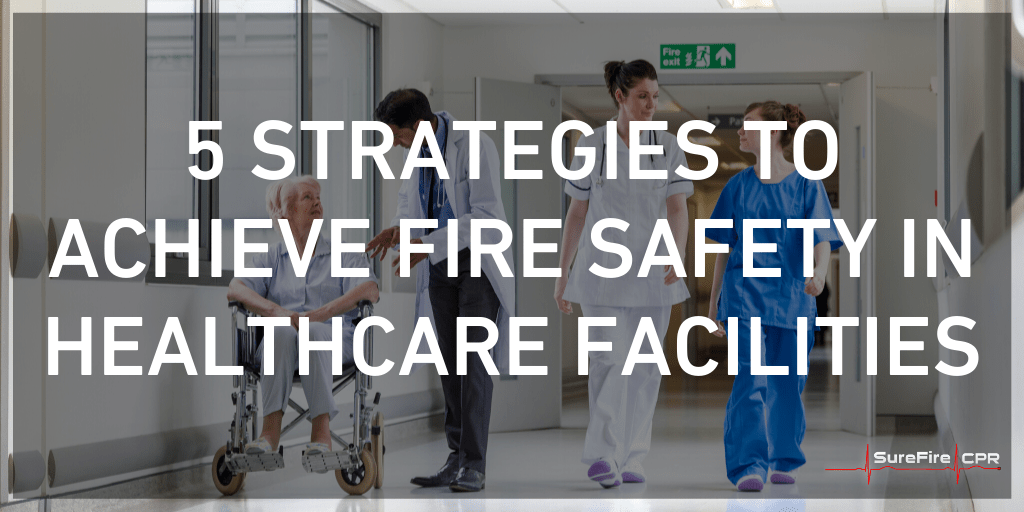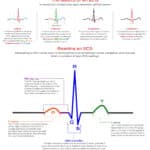No matter where you are, fire safety is important. In healthcare facilities — where the number of fire hazards and vulnerable individuals is extra-high — fire safety is absolutely imperative. Whether you are new to hospital fire safety or a seasoned life-saver looking for a few extra fire safety tips in your medical facility, this is the guide for you. Below, our fire safety experts here at SureFire CPR cover 5 strategies to achieve fire safety in any healthcare facility. Read on to learn how you can make your facility as fire-safe as possible, and enroll in a life-saving course from our award-winning team today!
Inspect and Fix Electrical Cords and Outlets
When improperly contained, electricity is a fire-started and an all-around fire-starter. The biggest problem areas for electrical fires aren’t appliances, but their cords and the outlets to which they are connected. In fact, the U.S. Fire Administration (USFA) found that one in every five non-confined fires is caused by overloaded outlets or faulty wiring. The same also study also identified “general materials” (a category that included the insulation around wires) as the primary cause of these fires.
So, what can you do to prevent electrical fires in your medical facility? Start by checking your existing cords and outlets. Are there any tears, holes, major kinks, or exposed wires in the cords? If so, they need to be replaced immediately. It’s also a good idea to avoid using extension cords whenever possible, as these cords are more susceptible to damage. If you do have to use extension cords, make sure they’re placed away from flammable materials (which means never placing them under rugs or carpets) and keep them out of areas where they might be damaged or difficult to inspect (like window sills, doorways, or the insides of walls).
For your outlets, check each plate make sure it’s not cracked, as cracks and holes can let in hazards like water, small animals, and even dust buildup that can lead to fires. If you have the resources, it’s also a good idea to have a member of your staff test each outlet to make sure it’s grounded and functioning properly. Lastly, check to make sure your outlets aren’t overloaded. Check your circuit breaker to determine how much power each switch can handle; then, check the voltage of the appliances you plan on plugging into outlets connected to that switch. You don’t want more volts than the switch can handle, as this can overload it.
Check the Kitchen
It may not be the first place you’d think to inspect in a medical facility, but the kitchen is one of the biggest sources of potential fire hazards on any property. That’s because most kitchens are home to a number of fire starters: including stovetops, ovens, fryers, and other appliances used for cooking. 2016 data from the National Fire Protection Association found that 61 percent of all fires in healthcare facilities originate in kitchens. While most kitchen fires stay contained, the few that don’t can become major safety risks for the entire building. Here are some tips from the Occupational Safety & Health Administration (OSHA) for improving fire safety in hospital kitchens.
- Provide professional employee training that covers the safe handling of kitchen equipment. Knowing how to properly use kitchen equipment will help your employees avoid fires. If you can, bring in a professional instructor to cover proper usage for each piece of equipment in your kitchen. If not, have your senior kitchen staff instruct new employees on how to use each kitchen appliance.
- Keep all grill and grill ductwork properly maintained and free of flammable residues. Dirty grill surfaces and ducts can harbor excess heat and ignite materials nearby. Clean these areas out daily to avoid starting a fire.
- Keep flammable items stored out of range of heat-producing equipment. Designate special cupboards or cabinets for all flammable materials. Make sure these storage spots are several feet from heat-producing equipment like stoves, ovens, or fryers.
- Routinely empty grease traps. Clogged grease traps can quickly lead to grease fires, which cannot be extinguished with water. To prevent a grease fire from happening in the first place, clean out your grease trap daily.
- Outfit your kitchen with up-to-code fire extinguishers. OSHA stipulates that fixed dry chemical fire extinguishing systems for grease fires must meet the requirements of 29 CFR 1910.160 Fixed Extinguishing Systems and 29 CFR 1910.161 Dry Chemical Fire Extinguishers.
Stop Smoking in Its Tracks
It’s no secret that smoking and fire safety don’t mix. Lit cigarettes have open flames that easily cause fires when combined with flammable material. One of the worst combinations is cigarettes and oxygen-dispensing machines. Fire needs oxygen, and more oxygen means more fire. Many patients who smoke also need oxygen, so it’s important to keep them from smoking at all times when they are using an oxygen machine or even sitting near one. If you have staff that smoke, keep smoking confined to a mandatory area away from medical equipment. As a last precaution, it’s a good idea to invest in deep ashtrays that are heavy to tip over. This will help reduce the list of fire from errant cigarette butts.
Install Fire Extinguishers and Wet-Pipe Sprinkler Systems
Even with the best preventative measures in place, fires can still happen. In the event that one strikes your hospital, you need infrastructure in place to put it out. Per OSHA regulations, you should place fire extinguishers no more than 50 feet apart in your building. If your building already has fire extinguishers, conduct monthly inspections to test for corrosion, leakage, and any other damage on each extinguisher.
The other important piece of fire-fighting equipment you need in your medical facility is a wet-pipe sprinkler system. Designed to discharge water immediately open detecting excess heat, these sprinklers are a great fire-fighting measure in instances when personnel may not be nearby. According to a study by the National Fire Protection Association (NFPA), the injury rate from fires was 27% lower in properties with sprinklers than in properties without them, and the death rate from fires was a staggering 87% lower in properties with sprinklers than in properties without them.
Train Staff in Hospital Fire Safety and Have an Emergency Response Plan for Fires
Every medical facility needs an emergency response plan for fires. This plan should cover the 4 Principles of Hospital Fire Safety: life safety, notification, fire extinguishing, and evacuation/relocation. You can start by clearly posting your hospital’s fire evacuation routes in every room in your medical facility. You can also schedule annual or bi-annual meetings to make sure all hospital staff know your evacuation plan and know how to sound the alarm over your hospital’s intercom system in the event of a fire. From there, it’s time to turn your hospital fire safety planning over to the professionals.
To ensure that each and every staff member in your medical facility fully prepared for fire safety, the best thing you can do is have them professionally trained. By enrolling in an accredited Hospital Fire Safety course, your staff will learn the following:
- What to Do in Case of a Fire at Your Hospital
- Patient Rescue (Including drags and carries)
- How to Use a Fire Extinguisher
- Different Types of Fires and How to Control Them
- Hospital Fire Protection Systems and Equipment
- How to Evacuate Safely
- Home Fire Safety
- Pre-Fire Planning
Our Hospital Fire Safety course here at SureFire CPR covers all of the above topics and lasts just 4 hours. Upon completing the course, all enrollees will receive a Blue Fire Safety Card for Acute Care Settings, is valid for 4 years.
Learn More About Hospital Fire Safety and Get Certified With Our Team
With these hospital fire safety strategies in your arsenal, the next step is to improve your skillset and make your hospital as safe as possible. At SureFire CPR, we’re here to help. Available to medical professionals in the greater Los Angeles area, our Hospital Fire Safety class is taught by award-winning instructors and structured to cover all essential aspects of fire prevention and response in medical facilities. Ready to enroll? Have more questions about hospital fire safety? Click the link above to sign up for one of our available classes, and contact our team for assistance and answers to your hospital fire safety questions.
Sources
U.S. Fire Statistics. U.S. Fire Administration (USFA). 2019.
Fires in Health Care Facilities. National Fire Protection Association. 2016.
Hospital eTool – Dietary. Occupational Safety & Health Administration (OSHA).
U.S. Experience With Sprinklers. National Fire Protection Association (NFPA). Marty Ahrens. 2017.











